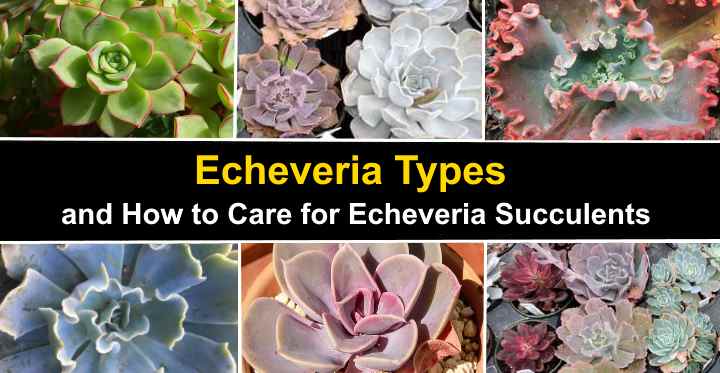Succulents like Echeverias are very popular for home or garden decorations. These small leafy plants require little care, are lovely to behold, and need little water. Echeveria has a rosette form with tiny triangular leaves and is one of the most popular varieties. Echeverias are available in a plethora of colors, forms, and textures, which is one of the reasons they are so popular.
The genus Echeveria belongs to the Crassulaceae family of tropical flowering succulent plants. Echeveria is a genus of 150 species that originated in Mexico and Central America. Thick green fleshy leaves characterize most echeveria succulents species.
Blue, silvery-green, light purple, light pink, gray, and light red leaves may be found in certain echeveria species. Echeverias are ideal houseplants because of their low growing habit and elegant appearance. Echeveria varieties may be planted together or in groups for a lovely plant display, along with other succulents or cactus. Echeverias create attractive plant for windowsills, bright areas, desks, and patios because they adore the sun.
How to care for echeveria plants: Plant echeverias in well-draining cactus/succulents potting soil and provide them with bright indirect light. Only use water when the topsoil is completely dry, and maintain a humidity level of 40% to 50%. Between 65 and 80°F (18 and 27°C) is the ideal temperature range.
Every three weeks in the summer, fertilize with a diluted low-nitrogen solution. This article will help you determine what sort of succulent you have by identifying the most common types of echeverias.
There Are Many Types of Echeveria Succulents to Choose From
Echeverias are considered by many to be one of the most attractive succulents. There are so many species to choose from because of the wide range of sizes and colors. Echeverias have plump fleshy leaves and a rosette shape that you can identify. Echeverias come in a variety of shapes and colors, from attractive rosette designs to ruffled lettuce types to spiky star-shaped succulents. Red, green, grayish-blue, pink, and silver-white echeveria succulents are also available to choose from.
Echeverias with multicolored leaves are even available in a variety of colors. Echeveria plants, which create bell-shaped blooms, are another kind of flowering succulent plant. The slender stems grow from tight rosettes with lovely pink, orange, or peach blooms. The “chicks” are smaller clones or ‘offsets’ that the mother plant (the “hen”) produces, and some of the most popular echeverias are also called “hens and chicks.”
How to Care for Echeveria Succulents (Echeveria Care Guide)
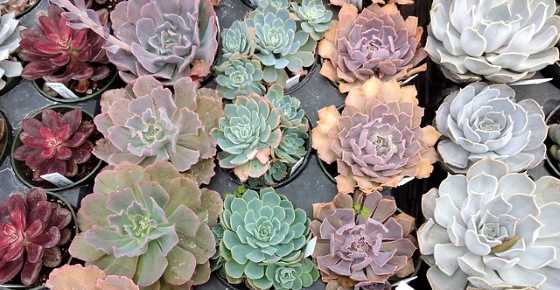
Echeveria succulents are low-maintenance plants, and one of the niceties of growing them is that they come in a variety of types. There are a few things to watch out for when caring for the plants.
Echeveria watering
Echeverias have succulent leaves that store water. They need plenty of water throughout the spring and summer to thrive. They should not be kept in wet dirt, though. When the top 1″ (2.5 cm) of soil is dry, water your echeveria. Until the water drains out of the bottom of the pot, pour water through the soil.
Don’t water again until the top soil has dried out after you’ve completed this. Water the earth, not the leaves, every time you water. Water your echeveria only when it’s required during the winter. Your echeveria will begin to wilt, wrinkle, or drop leaves if you water it too much or too little.
Echeveria succulent light requirements
Echeverias need full sun to thrive since they originate in tropical countries. As a result, put your echeveria in a location with bright light and direct sunlight for about an hour every day. To ensure that all sides of your echeveria get enough light, periodically turn the plant on a windowsill. Sunburn is a condition that results from spending too many hours in direct sunlight.
Climate
Echeverias thrive in partially humid conditions indoors, with a humidity level of 40% to 50%. Your indoor succulents demand temperatures of 65 to 80°F (18 to 27°C) throughout the spring and summer. It will be beneficial to keep the temperature a few degrees lower during the winter. If you have warm summers of at least 19°C or 20°C, you can grow echeverias outside.
Soil
Soil for cactus growing is also appropriate for succulents, as cacti are succulents too. Make sure there are drainage holes at the bottom of the container if you’re growing in containers. Echeveria root rot occurs when the soil is constantly wet or doesn’t drain properly.
Fertilizer for echeveria care
Echeverias are able to thrive in most soils and do not need any supplementary nutrients. You may, however, utilize a low-nitrogen solution that has been diluted three or four times above the suggested dosage to encourage healthy echeveria growth. Throughout the summer, feed your echeveria just a little bit every two or three weeks.
Container size
It’s crucial to pick the proper size echeveria for cultivation in a pot or container. For all succulents, choose a pot that is approximately the same size as the root ball. This prevents the soil from becoming overly wet.
Does Echeveria Need Grooming and Pruning?
Echeverias self-prune because they are a easy-care species of succulent. They just need to be wiped off with a damp cloth from time to time and any dead leaves or flowers should be removed.
Common Issues with Echeveria Care
The best strategy to keep your lovely echeveria plants healthy and happy is to give them enough water.
Succulent leaves turning yellow, brown, or falling off
It might be an problem with watering if leaves are falling off, looking wilted, yellowing, or browning. The health of your echeveria may be harmed by too much or too little watering. Low light is one of the reasons why echeveria leaves might become limp and fade. Always keep your echeveria succulents in bright environments with plenty of sunlight. Nonetheless, keep in mind that exposing the leaves to too much intense sunlight may scorch them, leaving them brown and patchy.
Mealybugs
Mealybugs are another frequent problem when caring for echeveria. These tiny insects may consume the plants, altering their development. Use a natural insecticide to address this issue, or spray the succulent thoroughly with water containing a little bit of dish soap. Until the infestation has passed, spray them continuously. You may want to spray the soil with insecticide if you have a big infestation since any mealybugs or eggs that are still in the soil may be eliminated this way.
Types of Echeveria (With Pictures)
In your garden or home, what is the optimum echeveria to cultivate? To discover which echeveria is the finest succulent for you, read through the descriptions and photos of the most common and vibrant echeverias.
Echeveria Elegans
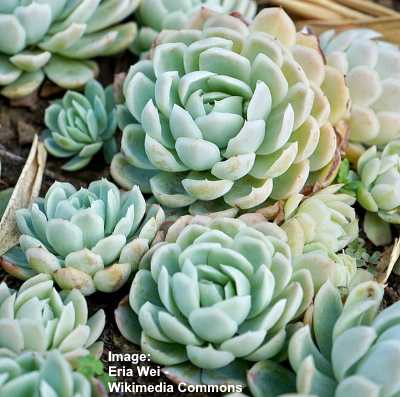
The Echeveria elegans is an evergreen perennial succulent that is also known as the “Mexican Snow Ball.” The open rosette-shaped thick fleshy light-green leaves look like a large pine cone and are in an open rosette pattern. In the winter or spring, this elegant succulent produces 10-inch (25 cm) pink blooming stalk.
Echeveria ‘Lola’

The species ‘Lola’ is one of the most appealing echeveria succulents. This plant grows to be about 6 inches (15 cm) tall and resembles a rosebud. When grown in full sunlight, the greenish-gray leaves become pink with a ovate shape.
Echeveria Deranosa
The little gray-green leaves of many succulents are found in the Echeveria Deranosa, a compact Mexican echeveria species. You’ll see lovely pink coloring around the leaf edges. The leaves form a rosette shape as they spread out.
Echeveria Agavoides (Molded Wax Agave)

Echeveria agavoides is commonly known as the “Molded Wax Agave.” The red pointed tip of the thick triangular leaves is pale green. Pink, red, or orange blooms emerge in the summer and are named for the succulent’s botanical name, which means “looking like an agave.” The crested species (Echeveria agavoides f. agavoides) is another fascinating kind of ‘Molded Wax Agave.’ (Cristata) The plant has tiny spiky leaves that clump together to create a rough look.
Echeveria Colorata
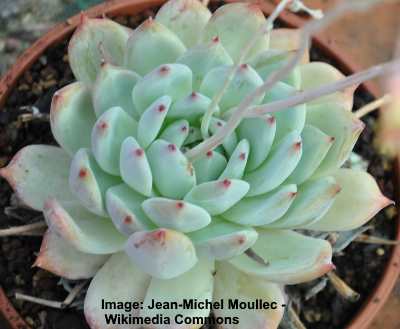
Echeveria Colorata is a huge succulent that grows up to 16 inches (40 cm) in diameter and is native to Mexico. Lance-shaped, arching upwards leaves with red tips on a silvery green background. In your room, office, or windowsill, this beautiful echeveria will add a touch of elegance and style.
Echeveria Galaxy Blue
With broad blueish wavy leaves and delicate red tips, the echeveria known as the Galaxy Blue is one of the most interesting succulents. A spectacular open rosette is created by the large leaves spreading out from the center. The succulent plant may grow to be 8 inches (20 cm) in diameter. The Galaxy Blue is a excellent option if you’re looking for an icy-blue succulent that commands attention.
Echeveria Lilacina

The silver-grey compact rosette head of the Echeveria lilacina resembles an artichoke head, and it is known as the ‘Ghost Echeveria’ or ‘Mexican Hens and Chicks.’ Each spoon-shaped silvery fleshy leaf narrows to a red tip. This huge echeveria species may reach a diameter of 6 inches (15 cm) and range from 4.7 to 10 inches (12 to 25 cm). The petals of this echeveria are pink and coral-colored bells when it blooms, which are known as ‘hens and chicks.
Echeveria Purpusorum

The spiky look of the rosette shape of the Echiveria pruposorum is unmistakable. This lovely plant is made up of tiny ovate fleshy leaves packed together. The leaf pattern is one of the appealing aspects. The leaves are olive-green or gray-green and have brownish-red dots. When it blooms, a long stem from the plant’s center is covered in little orange flowers.
Echeveria Peacockii

The rosette-shaped echeveria with silvery-green, red tipped leaves is also known as the Echeveria Peacockii and is classified as the Echeveria desmetiana. The leaves of this succulent form a lovely rosette and are oblanceolate in shape. The rosette size is 4.5 inches (11 cm) in diameter, and the leaves can grow up to 2 inches (5 cm) long. The variegated form of Echeveria peacockii is one of the most fascinating species. The leaves are light gray-green and pale yellow.
Echeveria Secunda
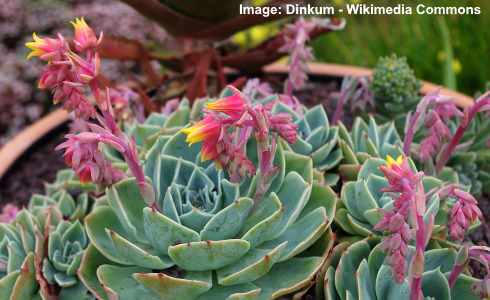
Echeveria secunda var. secunda The perfectly formed oval rosette with pale blue oval leaves makes the Echeveria Secunda a popular beauty. Pink or red lines around the edges of the succulent leaves add to its appeal. Secunda echeveria grows to be about 6 inches (15 cm) broad and stands around the same height as an adult. Succulents are excellent house plants or good ground cover for rock gardens.
Echeveria Setosa (Mexican Firecracker)
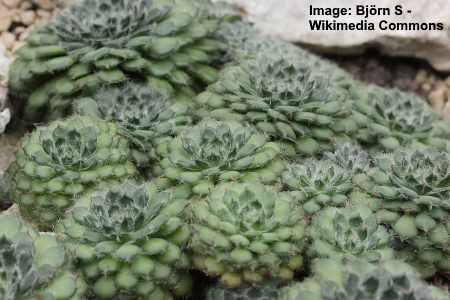
Var. Echeveria setosa Due to the small white hairs covering the green leaves, Echeveria setosa is often referred to as the “Mexican Firecracker.” The crimson tips on the spoon-shaped leaves are used to identify this succulent, which has a hairy look. This huge echeveria plant may grow up to 12 inches (30 centimeters) broad and 2 inches (4 centimeters) tall.
Echeveria Runyonii ‘Topsy Turvy’

Silvery spoon-shaped leaves create a starry rosette in the “Topsy Turvy” cultivar from the Echeveria runyonii species. The leaves of the succulent bend downward along their length but upwards at the tip, which is visible when you examine it from the side. The Topsy Turvy is one of the most stunning succulents you can cultivate. This echeveria variety thrives in a pot and provides excellent ground cover in a rock garden. It is a fast-growing species.
Echeveria Cubic Frost
The ‘Cubic Frost’ cultivar is another gorgeous echeveria succulent. With light lilac wavy leaves, this succulent is almost spherical in shape. Some of the heavier leaves have a icy-blue tint with pink blushings. to help the leaves take on their full color, put them in full sun.
The Cubic Frost has some of the most unusually shaped leaves you will find among many other succulents. The clusters of rosettes may be up to ten inches (25 centimeters) across. When the succulent produces rich orange-colored blooms, it becomes even more stunning.
Echeveria Joy’s Giant
One of the biggest on this list is the appropriately named echeveria dubbed ‘Joy’s Giant. The huge rosette of deep purple leaves is up to 20 inches (50 cm) across and is adorned with pink blushing. While it is too big to grow indoors, an echeveria plant in a cactus garden makes a stunning focal point.
Echeveria ‘Bumps’
This echeveria has a look that’s more like kale or lettuce than the typical echeveria form. The wavy ruffled margins and disheveled appearance of the rough leaves give it a bumpy appearance. Green, deep pink, blue, or lilac might also be present in the leaves. In pots on your windowsill or in a succulent rock garden, these striking examples of echeverias look fantastic.
Echeveria ‘Gorgon’s Grotto’
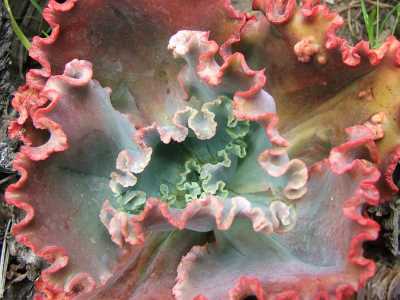
The echeveria cultivar ‘Gorgon’ looks like lettuce leaves and is another kind of succulent. The wavy crinkled leaves and burgundy or deep pink hues differentiate this succulent from others. The succulent plant has a spectacular look thanks to its broad, spreading leaves that fan out and curl up at the ends. These big echeverias are likely to reach a diameter of 12 inches (30 centimeters) and a height of 10 inches (25 centimeters).
Echeveria ‘Lipstick’
The ‘Echeveria Lipstick,’ which resembles a red echeveria, is one of the most stunning forms of this plant from the Agavoides family. The brilliant crimson on the tops of the leaves makes the rosettes look as if they’re on fire, even though the leaves are half-green.
Echeveria Affinis

The lance-shaped spiky leaves of the Echeveria Affinis are green-olive in color near the center, then dark purple, almost black at the tips. This perennial succulent can grow up to 8 inches (20 cm) wide and tall.
Echeveria ‘Dondo’
The ‘Dondo’ echeveria is a popular echeveria species with tightly packed waxy light green leaves. The leaves have a crimson tip and are usually elongated oval in shape. In late winter and early spring, the little rosette form develops a multiple flowering stalks.
Echeveria pulvinata
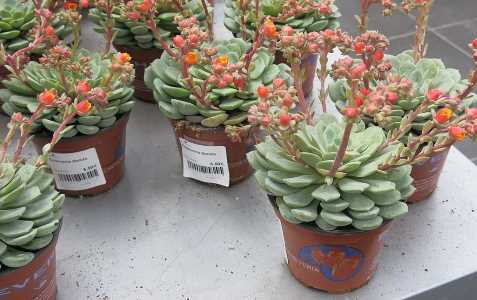
The Echeveria Pulvinata is a tiny shrub-like succulent plant that is also known as the Chenille plant or Plush plant. Its plump fleshy leaves have a hairy look, despite the fact that they do not have any distinguishing characteristics. This is one of the few fuzzy echeveria species that can be grown because to its tiny hairs. This succulent has a spreading nature and grows to approximately 12 inches (30 cm) tall.
Echeveria ‘Baron Bold’
The reddish-pink bumpy leaves with a warty texture identify the echeveria known as the Baron Bold. The rosette succulent will grow to be around 10″ (25 cm) in diameter and looks stunning in a pot.
Echeveria ‘Fun Queen’
One of the few succulents that has pale pink leaves is this evergreen succulent species. The leaves of these succulents have hints of green, yet pink is the dominant hue. Just about 1 inch (2.5 cm) tall and up to 2 inches (5 cm) in diameter, the small echeverias are easy to grow.
Echeveria ‘Encantada’
The pale, icy-blue leaves in the form of a teardrop give the echeveria ‘Encantada’ a frosty appearance. The light blue rosette has an enormous size of 15″ (37 cm) wide and grows together to form a stunning compactness. When the echeveria produces pale-blue or pink stems with tulip-shaped orange flowers at the tip, it becomes even more gorgeous.
